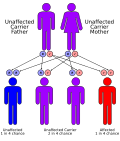Juvenile primary lateral sclerosis
| Juvenile Primary Lateral Sclerosis | |
|---|---|
| Synonyms | N/A |
| Pronounce | N/A |
| Specialty | N/A |
| Symptoms | Progressive muscle weakness, spasticity |
| Complications | N/A |
| Onset | Childhood |
| Duration | Chronic |
| Types | N/A |
| Causes | Genetic mutations |
| Risks | N/A |
| Diagnosis | Clinical evaluation, genetic testing |
| Differential diagnosis | N/A |
| Prevention | N/A |
| Treatment | Symptomatic management, physical therapy |
| Medication | N/A |
| Prognosis | Variable |
| Frequency | N/A |
| Deaths | N/A |
Juvenile Primary Lateral Sclerosis (JPLS) is a rare neurodegenerative disorder characterized by progressive muscle weakness and spasticity due to the degeneration of upper motor neurons. It is a form of primary lateral sclerosis (PLS) that presents in childhood, typically before the age of 20.
Etiology[edit]
JPLS is primarily caused by genetic mutations. The most common genetic mutation associated with JPLS occurs in the ALS2 gene, which encodes the protein alsin. Alsin is involved in the maintenance of motor neuron function, and mutations in this gene lead to the degeneration of upper motor neurons.
Clinical Presentation[edit]
The hallmark symptoms of JPLS include:
- Progressive muscle weakness
- Spasticity, particularly in the legs
- Difficulty with balance and coordination
- Hyperreflexia (exaggerated reflexes)
Unlike amyotrophic lateral sclerosis (ALS), JPLS does not typically affect the lower motor neurons, and therefore, muscle atrophy and fasciculations are not prominent features.
Diagnosis[edit]
Diagnosis of JPLS is based on clinical evaluation and the exclusion of other conditions. Genetic testing can confirm the diagnosis by identifying mutations in the ALS2 gene. Magnetic resonance imaging (MRI) of the brain and spinal cord may show degeneration of the corticospinal tracts.
Management[edit]
There is currently no cure for JPLS. Treatment focuses on managing symptoms and improving quality of life. This may include:
- Physical therapy to maintain mobility and reduce spasticity
- Medications such as baclofen or tizanidine to manage spasticity
- Assistive devices for mobility
Prognosis[edit]
The progression of JPLS is variable. Some individuals may experience a slow progression of symptoms, while others may have a more rapid decline. Life expectancy can be normal, but quality of life may be significantly affected by the degree of disability.
Also see[edit]
- Primary lateral sclerosis
- Amyotrophic lateral sclerosis
- Hereditary spastic paraplegia
- Motor neuron disease
References[edit]
- ,
Juvenile Primary Lateral Sclerosis: A Review, Journal of Neurology, 2020, Vol. 267(Issue: 5), pp. 1234-1240, DOI: 10.1007/s00415-020-09765-8,
- R.H.,
Motor Neuron Diseases, Elsevier, 2018, ISBN 978-0-12-809324-5,
Ad. Transform your life with W8MD's Budget GLP-1 injections from $75


W8MD offers a medical weight loss program to lose weight in Philadelphia. Our physician-supervised medical weight loss provides:
- Weight loss injections in NYC (generic and brand names):
- Zepbound / Mounjaro, Wegovy / Ozempic, Saxenda
- Most insurances accepted or discounted self-pay rates. We will obtain insurance prior authorizations if needed.
- Generic GLP1 weight loss injections from $75 for the starting dose.
- Also offer prescription weight loss medications including Phentermine, Qsymia, Diethylpropion, Contrave etc.
NYC weight loss doctor appointmentsNYC weight loss doctor appointments
Start your NYC weight loss journey today at our NYC medical weight loss and Philadelphia medical weight loss clinics.
- Call 718-946-5500 to lose weight in NYC or for medical weight loss in Philadelphia 215-676-2334.
- Tags:NYC medical weight loss, Philadelphia lose weight Zepbound NYC, Budget GLP1 weight loss injections, Wegovy Philadelphia, Wegovy NYC, Philadelphia medical weight loss, Brookly weight loss and Wegovy NYC
|
WikiMD's Wellness Encyclopedia |
| Let Food Be Thy Medicine Medicine Thy Food - Hippocrates |
Medical Disclaimer: WikiMD is not a substitute for professional medical advice. The information on WikiMD is provided as an information resource only, may be incorrect, outdated or misleading, and is not to be used or relied on for any diagnostic or treatment purposes. Please consult your health care provider before making any healthcare decisions or for guidance about a specific medical condition. WikiMD expressly disclaims responsibility, and shall have no liability, for any damages, loss, injury, or liability whatsoever suffered as a result of your reliance on the information contained in this site. By visiting this site you agree to the foregoing terms and conditions, which may from time to time be changed or supplemented by WikiMD. If you do not agree to the foregoing terms and conditions, you should not enter or use this site. See full disclaimer.
Credits:Most images are courtesy of Wikimedia commons, and templates, categories Wikipedia, licensed under CC BY SA or similar.
Translate this page: - East Asian
中文,
日本,
한국어,
South Asian
हिन्दी,
தமிழ்,
తెలుగు,
Urdu,
ಕನ್ನಡ,
Southeast Asian
Indonesian,
Vietnamese,
Thai,
မြန်မာဘာသာ,
বাংলা
European
español,
Deutsch,
français,
Greek,
português do Brasil,
polski,
română,
русский,
Nederlands,
norsk,
svenska,
suomi,
Italian
Middle Eastern & African
عربى,
Turkish,
Persian,
Hebrew,
Afrikaans,
isiZulu,
Kiswahili,
Other
Bulgarian,
Hungarian,
Czech,
Swedish,
മലയാളം,
मराठी,
ਪੰਜਾਬੀ,
ગુજરાતી,
Portuguese,
Ukrainian



